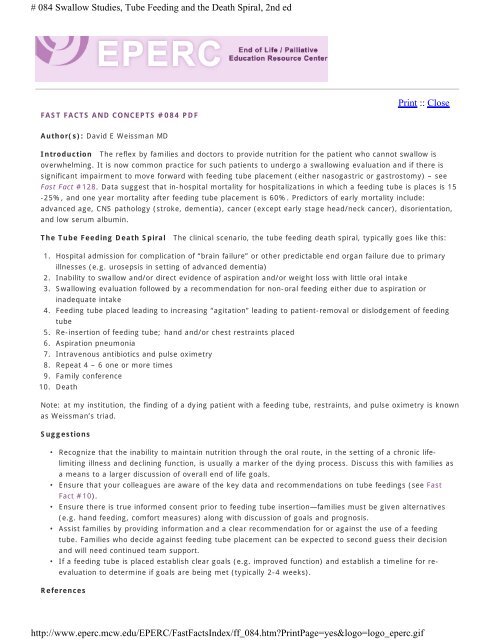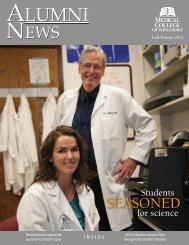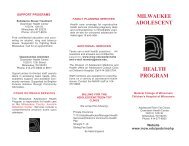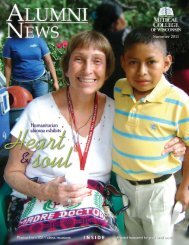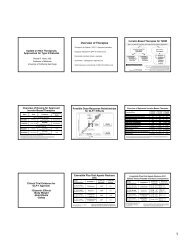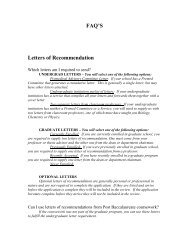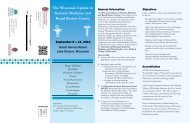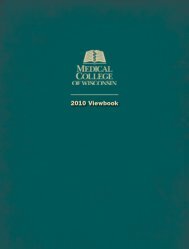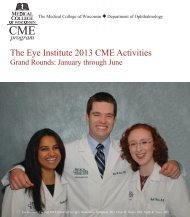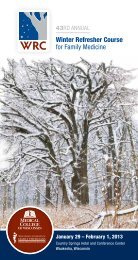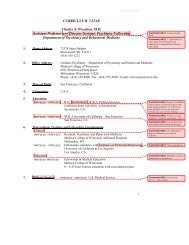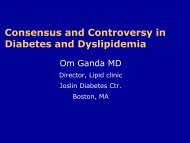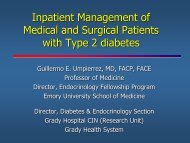Fast Fact #84. - Medical College of Wisconsin
Fast Fact #84. - Medical College of Wisconsin
Fast Fact #84. - Medical College of Wisconsin
- No tags were found...
Create successful ePaper yourself
Turn your PDF publications into a flip-book with our unique Google optimized e-Paper software.
# 084 Swallow Studies, Tube Feeding and the Death Spiral, 2nd edFAST FACTS AND CONCEPTS #084 PDFPrint :: CloseAuthor(s): David E Weissman MDIntroduction The reflex by families and doctors to provide nutrition for the patient who cannot swallow isoverwhelming. It is now common practice for such patients to undergo a swallowing evaluation and if there issignificant impairment to move forward with feeding tube placement (either nasogastric or gastrostomy) – see<strong>Fast</strong> <strong>Fact</strong> #128. Data suggest that in-hospital mortality for hospitalizations in which a feeding tube is places is 15-25%, and one year mortality after feeding tube placement is 60%. Predictors <strong>of</strong> early mortality include:advanced age, CNS pathology (stroke, dementia), cancer (except early stage head/neck cancer), disorientation,and low serum albumin.The Tube Feeding Death Spiral The clinical scenario, the tube feeding death spiral, typically goes like this:1.2.3.4.5.6.7.8.9.10.Hospital admission for complication <strong>of</strong> “brain failure” or other predictable end organ failure due to primaryillnesses (e.g. urosepsis in setting <strong>of</strong> advanced dementia)Inability to swallow and/or direct evidence <strong>of</strong> aspiration and/or weight loss with little oral intakeSwallowing evaluation followed by a recommendation for non-oral feeding either due to aspiration orinadequate intakeFeeding tube placed leading to increasing “agitation” leading to patient-removal or dislodgement <strong>of</strong> feedingtubeRe-insertion <strong>of</strong> feeding tube; hand and/or chest restraints placedAspiration pneumoniaIntravenous antibiotics and pulse oximetryRepeat 4 – 6 one or more timesFamily conferenceDeathNote: at my institution, the finding <strong>of</strong> a dying patient with a feeding tube, restraints, and pulse oximetry is knownas Weissman’s triad.Suggestions• Recognize that the inability to maintain nutrition through the oral route, in the setting <strong>of</strong> a chronic lifelimitingillness and declining function, is usually a marker <strong>of</strong> the dying process. Discuss this with families asa means to a larger discussion <strong>of</strong> overall end <strong>of</strong> life goals.• Ensure that your colleagues are aware <strong>of</strong> the key data and recommendations on tube feedings (see <strong>Fast</strong><strong>Fact</strong> #10).• Ensure there is true informed consent prior to feeding tube insertion—families must be given alternatives(e.g. hand feeding, comfort measures) along with discussion <strong>of</strong> goals and prognosis.• Assist families by providing information and a clear recommendation for or against the use <strong>of</strong> a feedingtube. Families who decide against feeding tube placement can be expected to second guess their decisionand will need continued team support.• If a feeding tube is placed establish clear goals (e.g. improved function) and establish a timeline for reevaluationto determine if goals are being met (typically 2-4 weeks).Referenceshttp://www.eperc.mcw.edu/EPERC/<strong>Fast</strong><strong>Fact</strong>sIndex/ff_084.htm?PrintPage=yes&logo=logo_eperc.gif
# 084 Swallow Studies, Tube Feeding and the Death Spiral, 2nd ed1.2.3.4.5.6.7.Finucane TE, et al. Tube feeding in patients with advanced dementia. JAMA. 1999; 282:1365-1369.Finucane TE, Bynum JP. Use <strong>of</strong> tube feeding to prevent aspiration pneumonia. Lancet. 1996; 348:1421-24.Cowen ME et al. Survival estimates for patients with abnormal swallowing studies. JGIM. 1997; 12:88-94.Rabeneck L, et al. Long term outcomes <strong>of</strong> patients receiving percutaneous endoscopic gastrostomy tubes.JGIM. 1996; 11:287-293.Grant MD, et al. Gastrostomy placement and mortality among hospitalized Medicare beneficiaries. JAMA.1998; 279:1973-1976.Mitchell SL. Clinical Crossroads: a 93-year-old man with advanced dementia and eating problems. JAMA.2007; 298:2527-2536.Cervo FA, Bryan L, Farber S. To PEG or not to PEG. A review <strong>of</strong> evidence for placing feeding tubes inadvanced dementia and the decision-making process. Geriatrics. 2006; 61:30-35.<strong>Fast</strong> <strong>Fact</strong>s and Concepts are edited by Drew A Rosielle MD, Palliative Care Center, <strong>Medical</strong> <strong>College</strong> <strong>of</strong><strong>Wisconsin</strong>. For more information write to: drosiell@mcw.edu. More information, as well as the complete set <strong>of</strong><strong>Fast</strong> <strong>Fact</strong>s, are available at EPERC: www.eperc.mcw.edu.Version History: This <strong>Fast</strong> <strong>Fact</strong> was originally edited by David E Weissman MD. 2nd Edition was edited by DrewA Rosielle MD and published October 2007. Current version re-copy-edited April 2009.Copyright/Referencing Information: Users are free to download and distribute <strong>Fast</strong> <strong>Fact</strong>s for educationalpurposes only. Weissman DE. Swallow Studies, Tube Feeding, and the Death Spiral, 2nd Edition. <strong>Fast</strong> <strong>Fact</strong>s andConcepts. October 2007; 84. Available at: http://www.eperc.mcw.edu/EPERC/<strong>Fast</strong><strong>Fact</strong>sIndex/ff_084.htm.Disclaimer: <strong>Fast</strong> <strong>Fact</strong>s and Concepts provide educational information. This information is not medical advice.Health care providers should exercise their own independent clinical judgment. Some <strong>Fast</strong> <strong>Fact</strong>s cite the use <strong>of</strong> aproduct in a dosage, for an indication, or in a manner other than that recommended in the product labeling.Accordingly, the <strong>of</strong>ficial prescribing information should be consulted before any such product is used.ACGME Competencies: <strong>Medical</strong> Knowledge, Patient CareKeyword(s): Non-Pain Symptoms and Syndromes<strong>Medical</strong> <strong>College</strong> <strong>of</strong> <strong>Wisconsin</strong>8701 Watertown Plank Road, Milwaukee, WI 53226www.mcw.edu | 414.955.8296Page Updated 05/17/2013Print :: Closehttp://www.eperc.mcw.edu/EPERC/<strong>Fast</strong><strong>Fact</strong>sIndex/ff_084.htm?PrintPage=yes&logo=logo_eperc.gif


